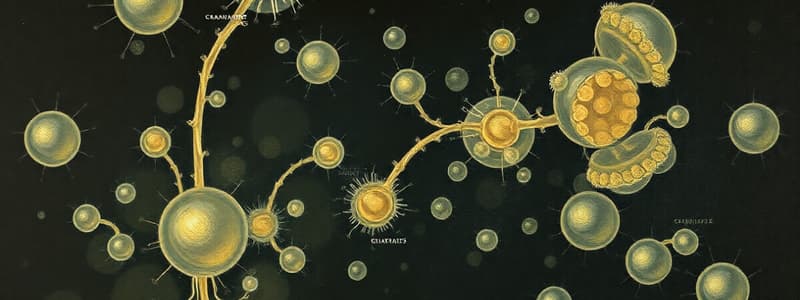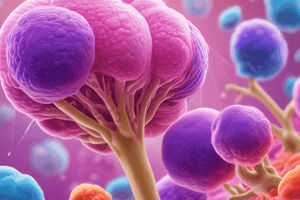Podcast
Questions and Answers
What characterizes a cycling metabolic pathway?
What characterizes a cycling metabolic pathway?
- Intermediates must be abundant for the pathway to function.
- It operates with an amphilbolic nature, utilizing catalytic intermediates. (correct)
- It has a linear progression with constant end product accumulation.
- It aims to avoid any accumulation of end products.
How do allosteric activators affect enzyme activity?
How do allosteric activators affect enzyme activity?
- They increase the Km and decrease Vmax.
- They prevent substrate binding at the active site.
- They decrease the Km and increase Vmax. (correct)
- They promote irreversible inhibition of the enzyme.
What is an example of feedback inhibition in metabolic pathways?
What is an example of feedback inhibition in metabolic pathways?
- The accumulation of intermediates to enhance enzymatic function.
- Substrates acting as feed-forward activators.
- Allosteric effectors binding at the active site.
- End products inhibiting key enzymes in the pathway. (correct)
Which of the following statements about spiral metabolic pathways is correct?
Which of the following statements about spiral metabolic pathways is correct?
What is the role of non-covalent allosteric effectors in enzyme activity modulation?
What is the role of non-covalent allosteric effectors in enzyme activity modulation?
What are the end products of glycolysis?
What are the end products of glycolysis?
How is glycolysis regulated?
How is glycolysis regulated?
What is the purpose of ATP in relation to glycolysis?
What is the purpose of ATP in relation to glycolysis?
What are the main products of the pentose phosphate pathway?
What are the main products of the pentose phosphate pathway?
What controls the pentose phosphate pathway?
What controls the pentose phosphate pathway?
What role does NADH play after glycolysis?
What role does NADH play after glycolysis?
What is controlling the glycolytic flux?
What is controlling the glycolytic flux?
How are energy stores created during glycolysis?
How are energy stores created during glycolysis?
What is the standard free energy change of ATP hydrolysis?
What is the standard free energy change of ATP hydrolysis?
Which reaction represents substrate-level phosphorylation?
Which reaction represents substrate-level phosphorylation?
How is the electrochemical potential of H+ calculated?
How is the electrochemical potential of H+ calculated?
In a prokaryotic cell, where is the classical respiratory chain located?
In a prokaryotic cell, where is the classical respiratory chain located?
Which form of energy is associated with NAD(P)+ and NAD(P)H?
Which form of energy is associated with NAD(P)+ and NAD(P)H?
The relationship between flux and rates in metabolic reactions can be described how?
The relationship between flux and rates in metabolic reactions can be described how?
Which component has a higher energy state that contributes to ATP synthesis during chemiosmotic coupling?
Which component has a higher energy state that contributes to ATP synthesis during chemiosmotic coupling?
What is the stoichiometry of NADH to ATP synthesis in the respiratory chain?
What is the stoichiometry of NADH to ATP synthesis in the respiratory chain?
What type of coupling is seen between H+ transport and ATP synthesis?
What type of coupling is seen between H+ transport and ATP synthesis?
What is the role of ATP in biological systems?
What is the role of ATP in biological systems?
What is meant by the term 'rate limiting step' in a metabolic pathway?
What is meant by the term 'rate limiting step' in a metabolic pathway?
What does the concept of 'Metabolic Control Analysis' suggest?
What does the concept of 'Metabolic Control Analysis' suggest?
What is the correct expression for the control coefficient in relation to enzyme concentration and flux?
What is the correct expression for the control coefficient in relation to enzyme concentration and flux?
How does an increase in ATP utilization rate affect the flux of glycolysis?
How does an increase in ATP utilization rate affect the flux of glycolysis?
What is the main conclusion from the concept of metabolic control?
What is the main conclusion from the concept of metabolic control?
What factor is NOT considered when analyzing the flux through a metabolic pathway?
What factor is NOT considered when analyzing the flux through a metabolic pathway?
In the context of pathways, what does flux (J) primarily refer to?
In the context of pathways, what does flux (J) primarily refer to?
Which of the following scenarios illustrates the concept of metabolic control best?
Which of the following scenarios illustrates the concept of metabolic control best?
What is the main product of glycolysis in yeast?
What is the main product of glycolysis in yeast?
Which enzyme is directly involved in the conversion of glucose to G6P in the metabolic pathway?
Which enzyme is directly involved in the conversion of glucose to G6P in the metabolic pathway?
In the biosynthesis of chitin, which molecule serves as a building block in the pathway?
In the biosynthesis of chitin, which molecule serves as a building block in the pathway?
According to the flux equation, how is the rate of chitin production calculated?
According to the flux equation, how is the rate of chitin production calculated?
Which compounds are involved in the regulation of chitin synthesis?
Which compounds are involved in the regulation of chitin synthesis?
Which enzyme is NOT part of the chitin biosynthesis pathway?
Which enzyme is NOT part of the chitin biosynthesis pathway?
What best characterizes the regulation of glycolysis in yeast?
What best characterizes the regulation of glycolysis in yeast?
Which step in the metabolic pathway shows the highest correlation with chitin deposition?
Which step in the metabolic pathway shows the highest correlation with chitin deposition?
What role does Gfa1p play in chitin biosynthesis?
What role does Gfa1p play in chitin biosynthesis?
How does transcription level affect chitin production?
How does transcription level affect chitin production?
What is the primary form of carbohydrate reserve present in yeasts?
What is the primary form of carbohydrate reserve present in yeasts?
In the metabolic pathways discussed, what does UTP convert into?
In the metabolic pathways discussed, what does UTP convert into?
Which aspect of cell metabolism does 'control' refer to in the context provided?
Which aspect of cell metabolism does 'control' refer to in the context provided?
What does the relationship slope of 0.90 signify in the context of chitin production?
What does the relationship slope of 0.90 signify in the context of chitin production?
Flashcards are hidden until you start studying
Study Notes
Glycolysis
- NADH is utilized in fermentation and aerobic respiration, regenerating NAD+ for glycolysis.
- ATP is consumed for anabolic reactions and converted to ADP and Pi in substrate level phosphorylation.
- End products of glycolysis include 2 pyruvate, 2 ATP, and 2 NADH.
- Glycolysis is regulated by key enzyme effectors, primarily by ATP levels.
- Glycolytic flux is controlled by Metabolic Control Analysis principles and homeostasis.
Pentose Phosphate Pathway (PPP)
- Major products of the PPP are NADPH and Ribose-5-P.
- PPP regulation depends on the NADPH/NADP+ ratio and also on ATP concentration affecting glucose-6-phosphate dehydrogenase.
Energy Forms in Cells
- Three forms of energy: Chemical (ATP), Redox (NAD(P)+/NAD(P)H), and Chemiosmotic (proton gradient).
- ATP is formed through substrate-level phosphorylation, yielding low ATP per glucose (e.g., 2 ATP in yeast fermentation).
Respiratory Chain
- Consists of four electron transport complexes in a membrane, essential for proton pumping.
- Prokaryotic respiratory chains are located in the plasma membrane, while eukaryotes have them in the mitochondrial inner membrane.
Metabolic Pathway Structures
- Linear pathways yield end-product accumulation (e.g., amino acid synthesis).
- Cycling pathways, like the Krebs cycle, maintain catalytic intermediates efficiently.
- Spiral pathways prevent dilution of intermediates, ensuring production stability (e.g., fatty acid metabolism).
Enzyme Activity Modulation
- Enzyme activity control occurs through allosteric regulation—non-covalent effectors affect Km and Vmax of enzymes.
- Feedback inhibition is common, such as ATP inhibiting PFK in glycolysis, while feed-forward activation involves substrate enhancement.
Metabolic Control Analysis (MCA)
- Defines control coefficients to quantify each enzyme's contribution to pathway flux.
- The flux of metabolic pathways can be impacted by changes in enzyme concentration or activity levels.
Chitin Biosynthesis in Yeast
- Chitin production flux correlates with the concentration of enzymes involved in its biosynthesis, particularly Gfa1p, Gna1p, and Agm1p.
- Control of chitin biosynthesis mainly occurs at the transcriptional level, indicating regulation strategies focus on gene expression dynamics.
Summary of Regulatory Concepts
- Regulation focuses on maintaining homeostasis within cells.
- Control relates to productivity and efficiency of metabolic pathways, influencing cellular output and energy usage patterns.
Studying That Suits You
Use AI to generate personalized quizzes and flashcards to suit your learning preferences.





